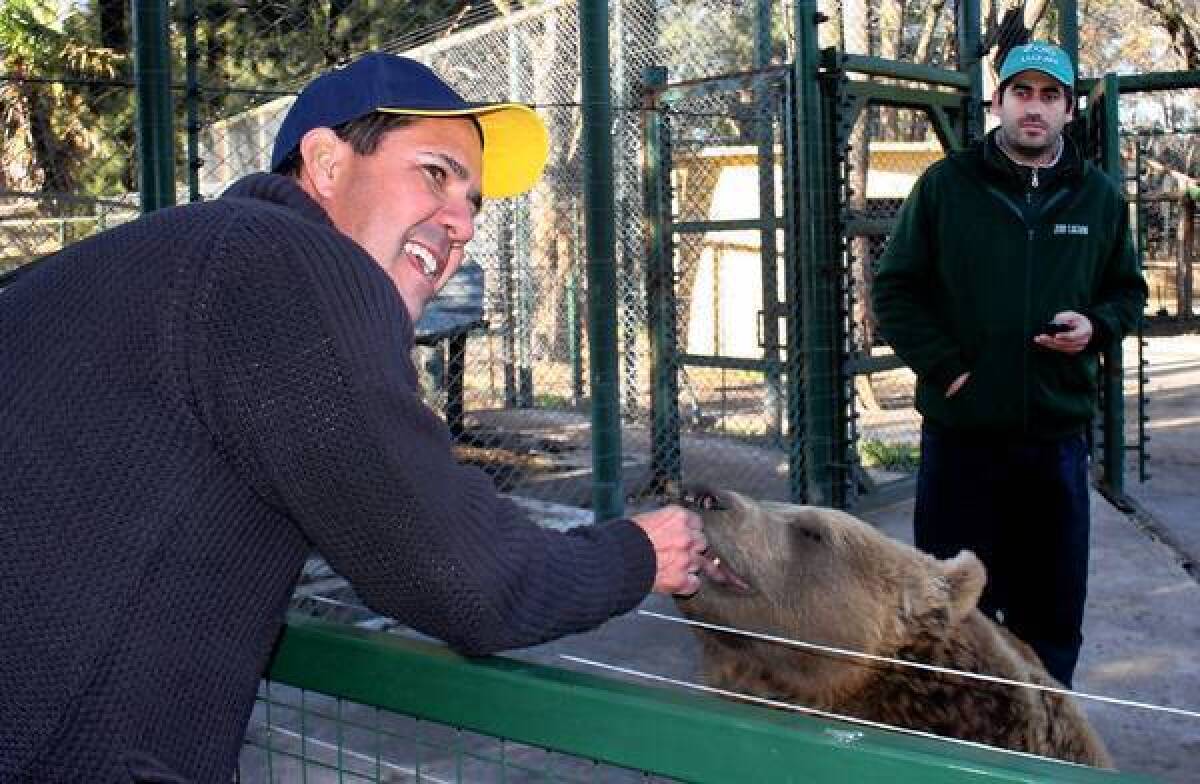In Argentina, a zoo that wants you to pet the tigers

LUJAN, Argentina — Manu Peclat, a tourist from Brazil, had already fed vegetables to elephants, thrown fish to seals and posed for pictures with two white tigers. Now it was time for the bears.
A zookeeper unlocked a gate and led Peclat and a few other visitors inside. After trading chunks of raw sweet potato for pesos, the keeper roused 3-year-old Gordo from his slumber.
The brown bear languidly lumbered over.
Peclat held out his hand and Gordo gently gobbled up the snacks. Their close encounter — they were near enough to kiss — lasted long enough for Peclat’s friends to snap several photos with their phones. Then they took turns feeding the bear.
At the private Zoo Lujan, a short bus ride from Buenos Aires, a $25 entrance fee allows visitors not just to look at the animals but to go inside their pens. While Peclat, a tourist from Brazil, was cozying up to Gordo, a group of high school students from the United States stroked the mane of a full-grown lion.
The zoo’s managers say that it’s all perfectly safe and that there have been no accidents since its opening in 1994. Animal rights activists say it’s only a matter of time before there’s a deadly mauling, and they accuse zookeepers of doping the animals to keep them docile.
***
It was a blustery day in the middle of Argentina’s winter. This being the slow season, only a few dozen visitors strolled the sprawling zoo grounds.
They were outnumbered by the animals.
The zoo’s collection includes 80 lions, 25 tigers, seven camels and three cougars, as well as monkeys, foxes, llamas and a herd of deer. Behind the cafeteria, two elephants padded around an enclosure and a group of sea lions splashed around in an above-ground pool that would have looked at home in a suburban American backyard.
The property, located on the border of a Buenos Aires suburb and the vast, flat countryside, was packed with cages as well as several dozen antique cars and tractors, giving it the feel of a surreal farm.
When owner Jorge Semino bought the zoo property in 1994, it had sat abandoned for several years. He knew a thing or two about how it worked because his family, which owned a farm, had supplied the zoo with food when it was functioning in the 1980s.
Semino started with two tigers and a lion, according to his cousin, Claudio Nieva, who is now the zoo’s manager and spokesman.
From the beginning, Semino wanted to breed animals tranquil enough for humans to touch, Nieva said.
Semino takes credit for developing an unusual system of domestication that begins even before the animal is born.
Take a pregnant tiger. In the final days of her pregnancy, she is sequestered and cared for by zookeepers, who massage the mother’s stomach and deliver her cubs. Their first contact outside the womb is with human hands. Instead of fighting with their siblings to nurse, they are placed, one by one, at their mother’s nipples.
The zookeepers continue the close interaction and make sure the growing tigers are never hungry. Soon the cubs are introduced to other animals — including trained dogs — which the zookeepers encourage to put the tigers in their place when they show signs of aggression.
That way, the official explanation goes, the tigers never realize their true strength.
Animal rights groups believe the zoo management keeps the animals tranquilized with drugs. How else would a grown tiger allow hundreds of people to pet him each day?
Nieva fiercely denies those accusations. Keeping the animals sedated day in and day out would be extremely costly and risky, he said: “Technically, it’s impossible.”
He said zookeepers take good care of their charges, although he acknowledged there’s no way of knowing what the animals think. He pointed to a lion, who was pacing her cage and letting out deafening roars: “I can’t interact with her and say, ‘Are you happy?’”
***
Two adult Bengal tigers were stretched out sleepily in a 20-by-20-foot cage, along with a group of dogs. At one point, the tiger known as Blanca moved to join the dogs, but one of them raced over to subdue her, barking and jumping on her from behind.
“This is to form their character, to make them more docile,” a zookeeper explained to two tourists who had just entered the cage. He took a plastic Sprite bottle filled with milk and shot it in Blanca’s mouth while another employee distracted the dogs. A camera clicked.
The visitors approached the other tiger, Sacha, but he seemed lethargic and was less willing to play. The zookeeper dragged a broomstick along a chain link fence above the tiger’s head and then prodded him on the paw. When the animal still didn’t move, the man knocked him with the broomstick on the face. Finally, Sacha picked his head up, and the camera clicked again.
Many visitors are delighted by the opportunity to get so close to such exotic animals. Thousands of pictures of smiling visitors to Zoo Lujan have been posted online, and the zoo’s managers say they get thousands of people each month. They say there are several zoos around the world that allow such intimate interaction.
Peclat, the Brazilian tourist, had heard the accusations that the animals are doped but didn’t believe them. He described his experience with Gordo the bear as very “licky” and declared his visit to the zoo a thrill.
“I love animals, I love wildlife,” he said. “We came here to touch them and not just see them behind bars.”
Not every visitor was as impressed.
Constanza Morales, 15, on vacation from Chile, said touching the tigers was no different than petting “a really big cat.” She and her father, Ariel, said they wished the zoo offered more diversity. She would have liked to see more monkeys, she said.
kate.linthicum@latimes.com
More to Read
Start your day right
Sign up for Essential California for news, features and recommendations from the L.A. Times and beyond in your inbox six days a week.
You may occasionally receive promotional content from the Los Angeles Times.







